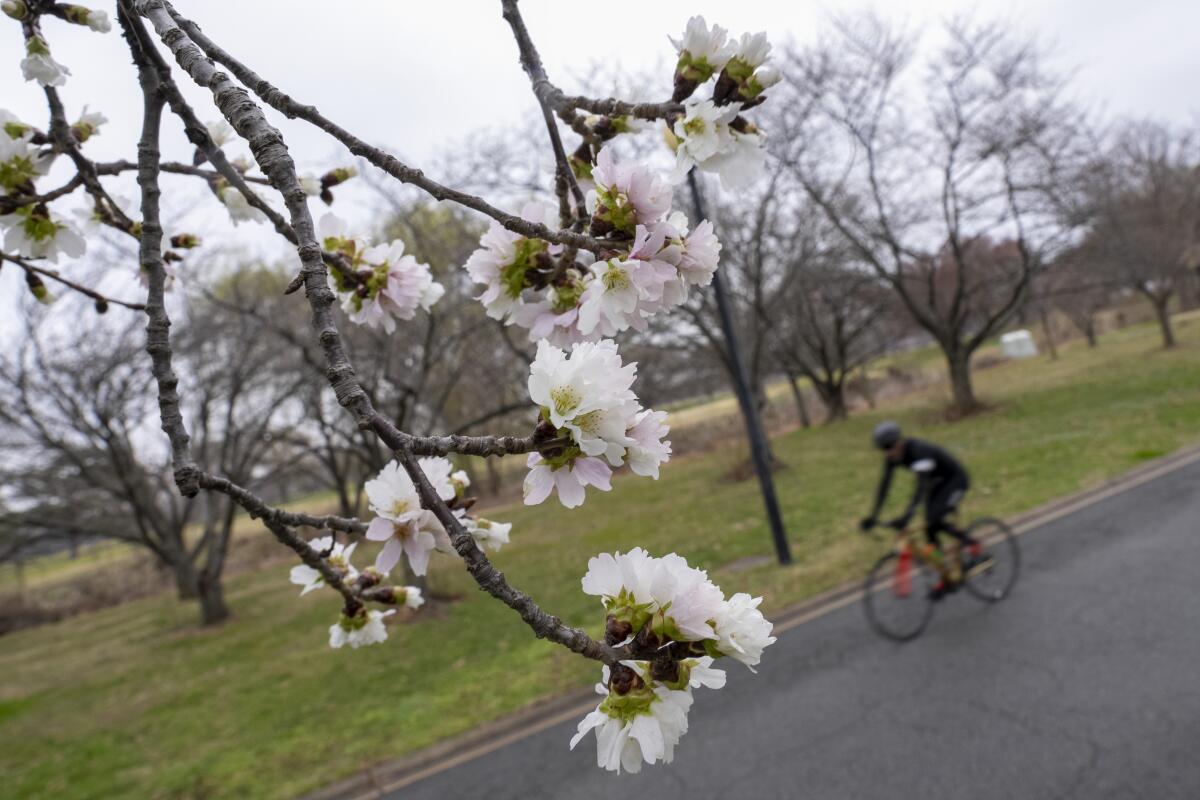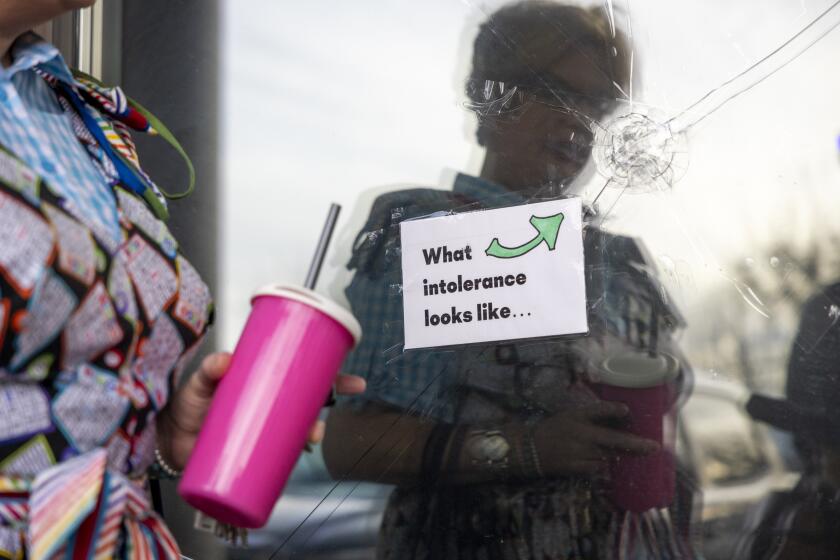D.C.’s cherry blossoms coming early due to confusing weather

- Share via
WASHINGTON — The cherry trees in the nation’s capital are confused by Earth’s changing climate, with the iconic blossoms appearing earlier than expected because of the unusually warm winter.
Washington Mayor Muriel Bowser and the National Park Service announced Wednesday that Washington’s 3,700 cherry blossom trees would reach peak bloom this year from March 22-25. That’s several days earlier than observers and experts had expected.
“This has been a challenging year to read the trees,” said Jeff Reinbold, NPS superintendent for the National Mall and memorial parks. One of the warmest winters on record and dramatic fluctuations in temperature have essentially sent confusing signals to the trees.
The district’s winter featured dramatic temperature shifts, including a week in February where it hit 81 degrees one day and briefly snowed two days later. The end results, Reinbold said, are trees that he compared to a hormonal teenager. “There’s a lot going on in there,” he said.
Dr. Simi, the lab-coated cartoon mascot of Mexico’s largest pharmacy chain, speaks to the failures of the nation’s public health system.
The early bloom, by itself, isn’t a huge problem, unless the temperatures drop suddenly again now that the vulnerable blossoms are emerging. “An early frost would definitely damage the blossoms,” Reinbold said.
Cherry Blossom Festival President Diana Mayhew said this year’s bloom dates aren’t unprecedented, but they’re the second-earliest she had witnessed in 23 years with the organization. As a result, her organization has accelerated its own timetable, moving up multiple events planned at the Tidal Basin by a week.
Mayhew said she and city officials are expecting a boom year for the festival, which typically signals the unofficial start of D.C.’s tourist season. The 2020 cherry blossom season was essentially wrecked in real time by the creeping shadow of the COVID-19 pandemic, which was moving across the country just as the festival was holding news conferences to announce that year’s peak bloom. Organizers finally were forced to cancel most in-person events.
Washington’s cherry blossoms date back 111 years to an original 1912 gift of 3,000 trees from the mayor of Tokyo. The Japanese Embassy has remained deeply involved in their maintenance and in the annual festival — organizing a host of cherry blossom-themed events and performances.
Koichi Ai, head of chancery for the Japanese Embassy, said Wednesday that the trees hold “special status” within Japanese culture. Their brief but spectacular bloom cycle represents “the transient nature of beauty and the everlasting cycle of life,” he said.
One of former President Carter’s biggest hopes is wiping out an infectious parasitic disease that’s plagued humans for millennia. How close is he?
The 2021 Cherry Blossom Festival took place fully under pandemic restrictions with organizers offering online bloom-cams and multiple virtual events and activities. Last year’s season drew an estimated 1.1 million visitors — close to the pre-pandemic average of 1.5 million. This year, Mayhew said she hopes to match or exceed those pre-pandemic numbers.
In their ongoing quest to maintain and protect the trees, NPS officials have to contend with a second climate change-related issue — regular flooding in the Tidal Basin due to rising sea levels. The 107-acre man-made reservoir where the largest concentration of trees is located now floods twice a day at high tide, submerging a stretch of sidewalk next to the Jefferson Memorial. During heavy rains that routinely occur in Washington, the floodwaters completely overflow the seawall in multiple locations and soak the tree roots with salty brackish water.
The original 1880s design of the Tidal Basin also simply wasn’t equipped to handle the kinds of crowds and traffic the area now receives. That traffic has only increased as more monuments have been added to the Tidal Basin area over the years: a memorial to Franklin Roosevelt opened in 1997, and the Martin Luther King Jr. Memorial was inaugurated in 2011.
Drag queens are more mainstream than ever, as are LGBTQ rights. Yet, story hours, where drag queens read to kids, have become a point of controversy and even violence.
In 2019, the NPS, along with the Trust for the National Mall and the National Trust for Historic Preservation, launched a long-term project to rebuild the basin’s deteriorating seawall and modify and expand sidewalks to accommodate modern crowds. Reinbold on Wednesday said the funding for the project had been secured and the proposed changes were in the design stage.
The twin impacts of confusing temperature shifts and Tidal Basin flooding represent a potential long-term threat to the health of the trees, according to Chris Walsh, a professor emeritus of horticulture at the University of Maryland. Warmer winters and fluctuating temperatures, he said, are producing similar early blooms this year in other flowering fruit trees such as apricots and pears.
“Everything’s ahead of schedule this year,” he said.
Since the cherry blossom trees aren’t relied on to produce fruit, the impact on them should be minimal and won’t harm the flowers — provided that there isn’t a cold snap. However, Walsh said the arboreal confusion could affect the annual development of protective bark, which could ultimately “put a lot of stress on the trees” and shorten their lifespan.
“If you add the stress of the fluctuating temperatures to the stress of salt on the roots, now you have two problems,” he said.
More to Read
Sign up for Essential California
The most important California stories and recommendations in your inbox every morning.
You may occasionally receive promotional content from the Los Angeles Times.













